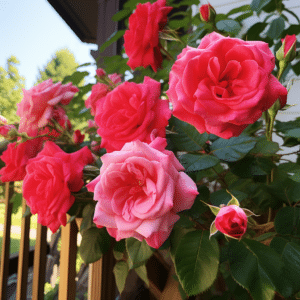Enriching your garden with the elegance of roses can be a rewarding experience. However, growing roses requires a blend of patience, knowledge, and care. This guide will walk you through the steps to cultivate beautiful roses right in your backyard.
Understanding the Basics of Rose Gardening

Before you start planting, it’s essential to understand the basic requirements of rose plants. Roses are sun-loving plants that need at least six hours of sunlight each day. They also prefer well-drained soil with a pH level between 6.0 and 6.5.
There are over 300 species of roses, each with its unique characteristics. Some common types include Hybrid Teas, Floribundas, and Climbers. Knowing the type of rose you wish to grow can help you provide the right care and conditions.
Choosing the Right Rose Variety
Choosing the right variety of roses depends on your garden’s size, climate, and personal preference. Hybrid Teas are popular for their large, colorful blooms, while Floribundas are known for their continuous flowering. Climbers, on the other hand, are perfect for covering walls and fences.
Consider the disease resistance, growth habit, and bloom time of the rose variety before making a choice. Some roses bloom once a year, while others offer multiple blooming cycles.
Planting Your Roses
Once you’ve chosen your rose variety, it’s time to plant. The best time to plant roses is in the early spring or fall. Avoid planting in the summer as the heat can stress the plants.
Start by digging a hole wide and deep enough to accommodate the roots of the rose bush. Place the rose in the hole, ensuring that the bud union is level with or slightly above the ground. Backfill the hole with soil, firm it gently, and water thoroughly.
Spacing Your Roses

Proper spacing is crucial for healthy rose growth. It allows for good air circulation, which reduces the risk of diseases. As a rule of thumb, space your roses about 2-3 feet apart. For larger varieties like Climbers, allow for more space.
Remember to consider the mature size of the rose bush when spacing. Overcrowding can lead to competition for resources and hinder growth.
Caring for Your Roses
Roses require regular care to thrive. This includes watering, fertilizing, pruning, and protecting them from pests and diseases.
Water your roses deeply but infrequently, aiming for the soil and not the leaves. Overhead watering can lead to fungal diseases. Fertilize your roses in early spring and throughout the growing season for healthy growth.
Pruning Your Roses
Pruning helps to improve air circulation, encourage new growth, and maintain the shape of your rose bush. The best time to prune is in early spring, just before new growth starts.
Use sharp, clean pruning shears to cut back dead, damaged, or crowded branches. Make your cuts at a 45-degree angle, about 1/4 inch above a bud that is facing
Protecting Your Roses from Pests and Diseases
Roses can be susceptible to a variety of pests and diseases, including aphids, black spot, and powdery mildew. Regular inspection can help detect problems early and prevent them from spreading.
Use organic or chemical controls as necessary, following the manufacturer’s instructions. Remember, healthy plants are less likely to succumb to pests and diseases, so proper care is your best defense.
Enjoying Your Roses
With proper care and attention, your roses can provide you with years of beauty and enjoyment. Whether you’re growing roses for their stunning blooms, their fragrant scent, or their ability to attract wildlife, the rewards are well worth the effort.
Remember, growing roses is a journey, not a destination. So take your time, learn from your experiences, and most importantly, enjoy the process.